It’s easy to assume that during the winter months there wouldn’t be much you can do in the garden.
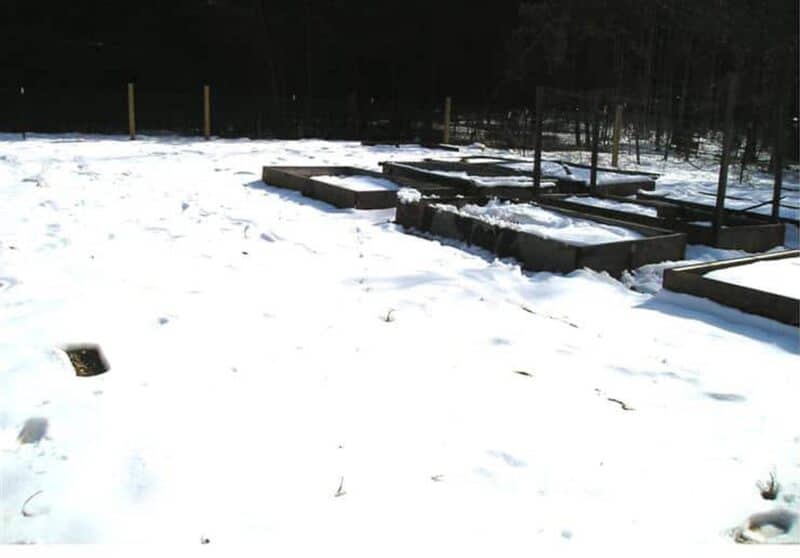
Unless you live in a warm climate, or you extend the growing season by using a green house or row covers, typically the ground is resting until Spring revives it once again.
But just because the soil is frozen solid and the daylight hours dwindle it doesn’t mean you get a break. Oh no, there’s far too much to be doing to get ready for spring!
Cleaning Up
At the end of the growing season, there is a lot to be cleaned out of the garden.
Withered vines, weeds, rotten fruits that have fallen to the ground, plants at the end of their lifecycle, stakes and trellises, pots and containers… All of these things need to be pulled up and removed from your growing area to keep it tidy and in good shape.
Natural materials can be composted, trash thrown away, pots emptied and washed out, and re-usable materials rolled up or packed away in storage.
Mending / Building Fences
Assuming you’re not under several inches of snow and the ground isn’t rock hard, the wintertime offers a great opportunity to mend or build fences and fix broken gates.
It’s best to do it while the weeds are dormant and you aren’t busy with the many other outdoor chores that come with Spring.
Building A Compost Pile
Now is a great time to be throwing all of your compostable materials into a pile for later use in the garden.
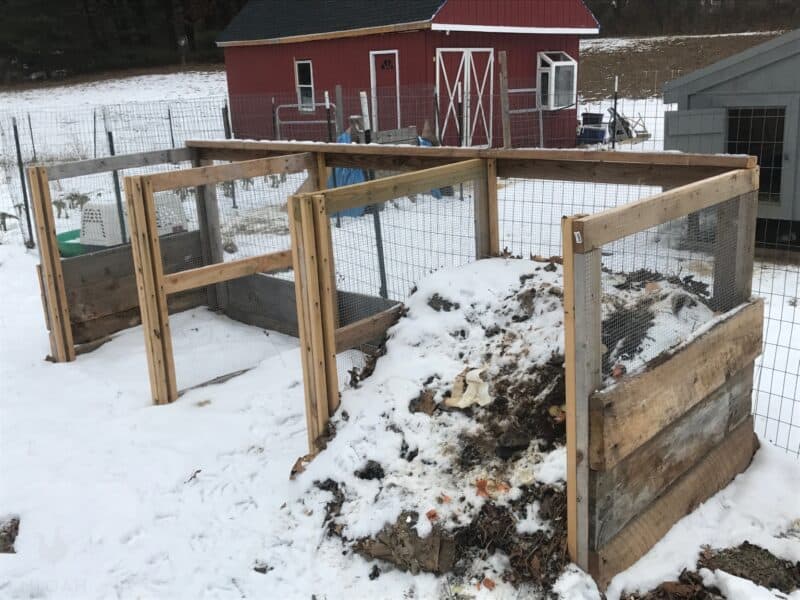
It might not be ready to use by Spring, but the sooner you start your compost pile, the sooner you’ll have that rich “black gold” to nourish your growing garden.
Ordering Seeds
If you’re like me, your mailbox has been flooded with seed catalogs by now. If not, you can always search stores online or request a catalog. My favorite place to order seeds from is Baker Creek Heirloom Seeds. You can request their free catalog HERE.
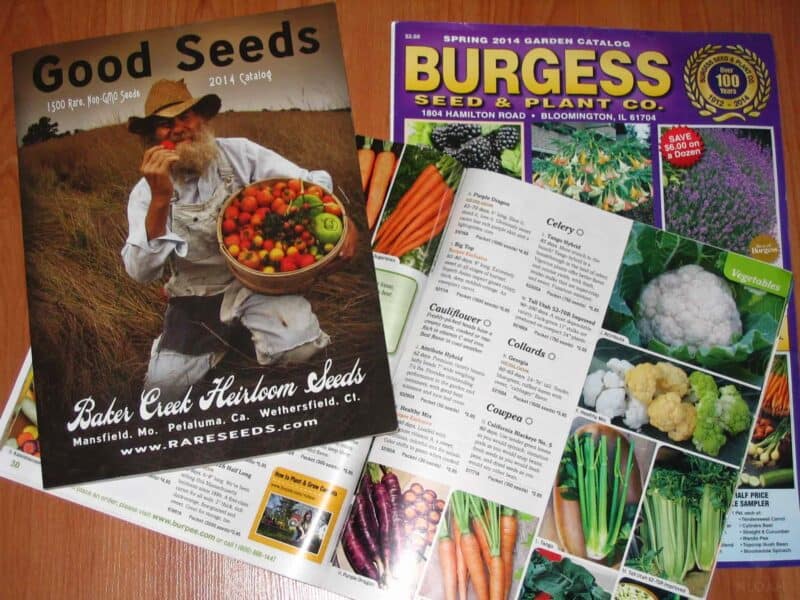
If this is your first garden, I recommend that you go slow and start by growing a few things that your family is already in the habit of buying and eating. If you have a little experience under your belt, I would encourage you to find a few new, fun varieties to try this year!
Planning Next Year’s Garden
Before you start your first seeds, you need to have an idea of where you’ll be planting everything. Sketch out a plan of what your garden will look like, and where all of your plants will go.
Remember to rotate your crops from where they were planted last year to avoid pest problems. Think about companion planting for best results, and vertical gardening to make the most of your space.
Do Your Research
If you will be growing something new, or if you encountered unsolved problems in the garden last year, now is a great time to read up on how to best handle them next season.
You might even study different methods of gardening to experiment with this Spring. Use the time you’re stuck indoors to build up a storehouse of knowledge to draw from in the coming months.
I’ve been looking up a few issues I had with my plants, and printing off homemade recipes for pest and disease control to try this year. You might add a few gardening books to your library while you wait for Spring.
Build Bird Houses
This is a great activity to have the kids help you with during the cold winter months. Bird houses aren’t just pretty, they’re also extremely useful in the garden.
Bluebirds, Chickadees, Phoebes, Sparrows, Swallows, and Wrens all provide excellent pest control, and help to reduce the number of pesky critters consuming your hard work in the garden.
Invite helpful birds to live around your garden, and your plants will benefit from their voracious appetites for bugs.
Constructing Cages
If you have the space to store them, now it’s great time to start constructing cages for your tall plants, such as tomatoes and peppers.
There’s a really good tutorial on how to do it here. At least start gathering the materials so you have them ready and waiting.
Gardening Tool Maintenance
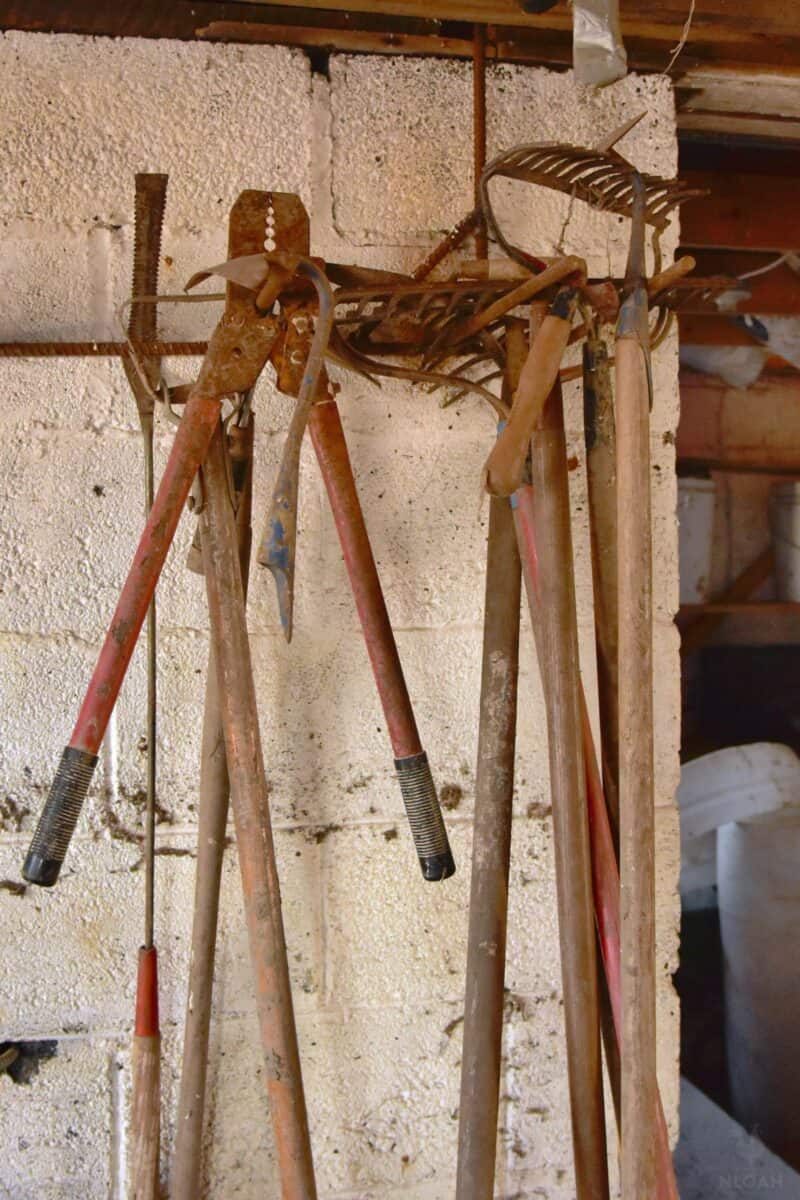
Really this should be done as soon as your growing season is over, but if you haven’t done it already now is a good time to clean and sharpen your garden tools to be in tip-top shape in Spring. Otherwise, they’ll just start to rust.
Start Seeds Indoors
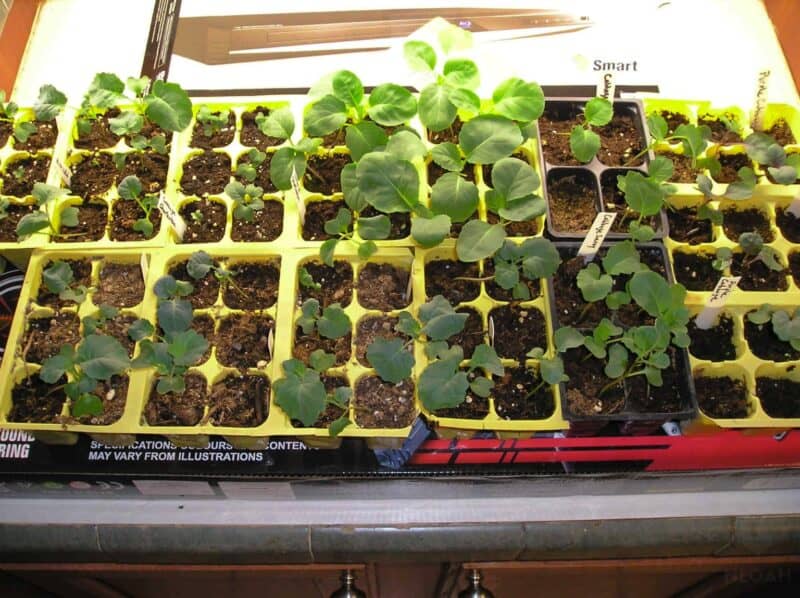
Many gardeners believe that the only time to plant is in the spring, but this isn’t necessarily true. In fact, winter can be an ideal time to start seeds indoors. Starting seeds requires some basic supplies, including pots, potting soil, and a source of heat and light.
Once you have these supplies, you can fill your pots with soil and sow your seeds. Be sure to keep the soil moist but not too wet, and within a few weeks, you should see your seedlings start to emerge.
Winter seed starting can be a great way to get a jump on the growing season. By starting your plants indoors, you can ensure that they are well-established by the time spring arrives.
As a result, you’ll be able to enjoy a bountiful harvest come summertime.
You’ll want to find out when the last expected frost date is for your area, and then count back 6-8 weeks. This will be the date that you can start your own seeds indoors.
Make DIY Garden Markers
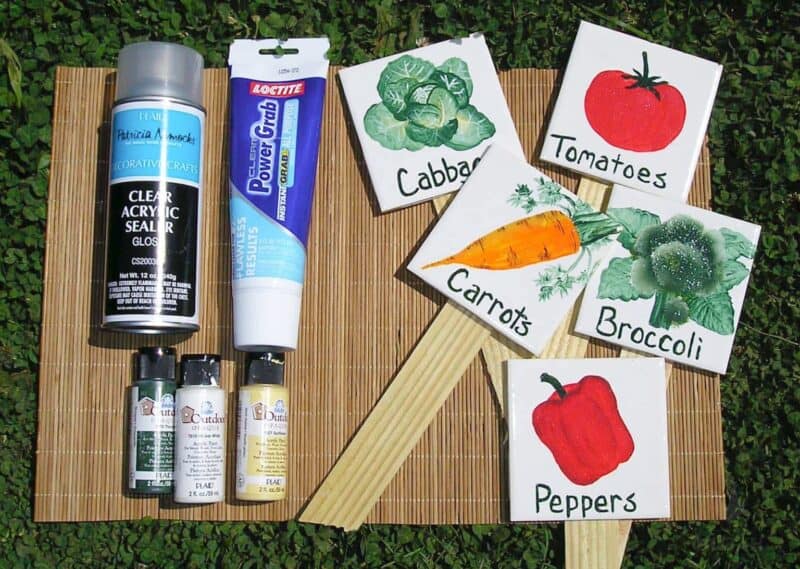
Painting garden markers, or making seedling labels from broken blinds or popsicle sticks is another fun activity to do indoors while you wait for Spring. Get creative!
Adding Mulch
In the winter, gardens can often look dull and lifeless. The bare ground and dead leaves can make even the most vibrant garden seem bleak. Fortunately, there is an easy way to brighten up your winter garden: adding mulch.
Mulch is a layer of material, such as wood chips or straw, that is spread over the ground.
It helps to insulate the soil, protect plant roots from cold damage, and prevent weeds from taking root. In addition, mulch can add visual interest to a winter garden.
By contrast, if you do not add mulch to your garden in the winter, it is likely that it will become overrun with weeds, and the soil will become compacted and difficult to work with in the spring. As a result, adding mulch is an essential winter gardening chore.
Prune Certain Plants and Dead Limbs or Branches
As any gardener knows, pruning is an essential part of plant care. Not only does it help to remove dead or diseased limbs, but it also encourages new growth and allows light and air to reach the center of the plant.
When pruning, be sure to use clean, sharp shears or saws. This will help prevent the spread of disease. Make sure to prune branches that are crossing or rubbing against each other, as well as any dead or dying limbs.
If you have any questions about how or when to prune a particular plant, consult a gardening guide or speak to a nursery staff member.
Clean Up Any Leaves
You should also take the time to rake up and compost any leaves that have fallen in your garden. This will help to tidy up your garden and also provide essential nourishment for your plants.
Fallen leaves are rich in nutrients, which can help to encourage new growth in the spring.
In addition, clearing away leaves helps to reduce the risk of disease and pests. If left on the ground, leaves can provide an ideal breeding ground for harmful fungi and insects.
Tend to Your Lawn
As any gardener knows, a healthy lawn is essential for a beautiful garden. Not only does it provide a lush green backdrop for your flowers and vegetables, but it also helps to prevent soil erosion.
However, keeping your lawn healthy during the winter can be a challenge. The cold weather can damage the grass, and the snow can bury the blades and prevent them from getting the sunlight they need.
As a result, it’s important to take some time to tend to your lawn during the winter months. Here are a few tips:
- Use a rake to remove leaves and other debris from your lawn. This will help the grass to get the sunlight it needs.
- Apply a layer of mulch around your plants. This will help to protect the roots from the cold weather.
- Water your lawn regularly. Even though it’s cold outside, the grass still needs water to stay healthy.
Clean Out the Garage
One of the most important winter gardening chores is to clean out the garage. This may seem like a tedious task, but it’s essential for getting rid of all the accumulated leaves, twigs, and debris that can harbor pests and diseases.
In addition, cleaning out the garage gives you a chance to inspect your gardening tools and make sure they’re in good condition.
Maintain Your Bird Feeder
One winter gardening chore that is often overlooked is maintaining your bird feeder.
Bird feeders can become covered in mold and mildew, making them unsightly and uninviting for feathered friends. In addition, old seeds can attract rodents and other pests.
To keep your bird feeder looking its best, scrub it with a solution of vinegar and water, and empty out any old seed.
Make New Raised Beds
One important winter gardening chore is to make new raised beds. Raised beds offer many benefits, including improved drainage, better aeration, and easier weed control. In addition, raised beds can be custom-designed to fit any space, making them ideal for small gardens.
If you’re planning to make new raised beds, now is the time to start gathering materials. Be sure to choose a sturdy wood that will withstand the elements and last for years.
Grow Cold Weather Crops in Cold Frames
For gardeners in cold climates, winter can be a long and difficult season. With the ground frozen solid and the days short, it can be hard to find things to do in the garden. However, one important winter gardening chore is to grow cold weather crops in cold frames.
Cold frames are simply boxes with clear roofs that are placed over existing beds. They provide a place for plants to get the sun and warmth they need to grow during the winter months.
While it is possible to buy cold frames, they are relatively easy to build out of recycled materials.
Plant Bulbs
Planting bulbs in the fall is an important gardening chore. By doing this, you ensure that your garden has a colorful display in the spring.
Bulbs need to be planted before the first frost, so it is important to check the weather forecast and plan accordingly. When choosing bulbs, look for ones that are plump and have not begun to sprout.
Once you have selected your bulbs, dig a hole that is twice as deep as the bulb is tall. Place the bulb in the hole with the pointed end facing up, and then cover it with soil. Water well and mulch heavily to protect the bulbs from frost damage.
Put Out Manure or Other Fertilizers
One important task is to put out manure or other fertilizers. This will help to ensure that your garden gets the nutrients it needs to grow healthy plants in the spring.
Manure is a great source of nitrogen, phosphorus, and potassium, which are essential for plant growth.
It’s also relatively easy to find and relatively inexpensive. You can usually find it at your local gardening store or online. Just be sure to follow the directions on the package carefully so that you don’t overdo it and damage your plants.
Start a Garden Notebook
Gardeners need to take care of a number of important tasks during the winter months, including starting a garden notebook.
A garden notebook is an essential tool for any gardener, but it is especially important for those who are just starting out. In the notebook, you can keep track of which plants you have planted where, as well as when you need to water them and fertilize them.
You can also use it to jot down ideas for next year’s garden, or to record how your plants are doing from one year to the next.
Starting a garden notebook may seem like a simple task, but it can be invaluable in helping you to create and maintain a beautiful winter garden.
Plan Ahead to Prevent Garden Pests
One of the most important winter gardening chores is to take steps to prevent garden pests. Overwintering pests can devastate a garden, so it is important to take measures to eliminate them before they have a chance to take hold.
One way to do this is to remove all plant debris from the garden at the end of the growing season. This includes removing dead leaves, stems, and roots.
Pests often overwinter in plant debris, so getting rid of it can help to reduce their numbers. In addition, it is important to keep the garden clean throughout the winter. This means removing any fallen leaves or other debris that could provide shelter for pests.
Bring Potted Plants Inside to Care for Them There
Although it is possible to leave potted plants outside during the winter, it is often better to bring them inside. Winter weather can be harsh, and even plants that are typically hardy can suffer from the cold, wind, and snow.
By bringing potted plants inside, you can protect them from the worst of the winter weather and ensure that they will still be healthy and thriving come spring. Just be sure to give them plenty of light and water, and they should do just fine over the winter months.
Plant a Cover Crop
This winter, consider planting a cover crop in your garden. Cover crops are beneficial plants that are grown to protect and improve the quality of the soil. They help to prevent erosion, increase organic matter, improve drainage, and provide habitat for beneficial insects.
In addition, cover crops can act as a green manure, adding vital nutrients to the soil when they are turned under in the spring.
When choosing a cover crop, it is important to select one that is well-suited to your climate and growing conditions. Some common cover crops include annual ryegrass, vetch, buckwheat, and clover.
Take a Soil Test
Although most people associate soil testing with the spring planting season, taking a soil test in the winter can actually be beneficial. For one thing, it can give you a head start on crafting your garden plan for the following year.
By knowing the nutrient levels in your soil, you can make sure to add the right amendments to achieve optimal plant growth.
Additionally, taking a soil test in the winter can help to identify potential problems that could arise in the spring, such as nutrient deficiencies or drainage issues.
Cover With Tarps to Kill Weeds
One important winter gardening chore is covering the garden with a tarp to kill weeds. This helps to prevent the weeds from taking over the garden and competing with the plants for resources. It also helps to prevent the spread of diseases and pests.
Fix Trellises
Winter is the perfect time to take care of those gardening chores that are difficult to do during the growing season. One such chore is repairing trellises.
Trellises can be damaged by wind, rain, and snow, and if they are not properly repaired, they can collapse under the weight of heavy vines.
To fix a trellis, first inspect it for broken or loose parts. Then, use strong wire or rope to secure any loose parts, and replace any broken pieces. Finally, give the trellis a fresh coat of paint or sealant to protect it from the elements.
Final Thoughts
There’s too much to be doing to be bored during the winter months! Pick a project, get it done, and move on to the next. Spring is just around the corner!!
What winter garden chores would you add to the list?

A city girl learning to homestead on an acre of land in the country. Wife and homeschooling mother of four. Enjoying life, and everything that has to do with self sufficient living.

Hi Kendra! This is an excellent winter list!
Have you heard of birdhouse gourds? They’re a hard shelled squash that is frequently used to make birdhouses. They could be a fun crop for young children to tend to, and emptying the gourds and then painting them could be a fun family winter “chore”.
So I have a family of 7 and we have a beef and dairy farm but would really like to not have to buy anything from the store…would you know about how much garden and or vegi to grow per person to last the winter? If it helps at all my kids eat everything and I mean everything we just can’t fiND anything that will tell is how much you need to be fully store free
Thanks
Charity,
Here is a general guideline to help you in figuring out how much to plant for your family: https://www.newlifeonahomestead.com/how-much-should-i-plant/
That’s a great list! I’m working on a few of those now myself. Planting seeds is in the forefront at the moment. I always have WAY too many seeds to plant in one season. Soon we will be able plant the cold weather seeds!
Best wishes for your garden this year, Sheryl!
Hi Kendra,
I found your blog looking for garden markers…love the painted ones on tile. I too had the same problem with our plastic popsicle sticks and “permanent” marker last year. By the end of the season the sun had bleached the names right off the sticks. I was googling pictures of peppers to see what we had! We planted at least 10 different unusual ones…my husband loves peppers. So, here in Northern NY, it won’t be until late May when I can plant, so I’ll plan my garden and make some markers.
On a separate note…do you have any advice for tomato blight? Or point me to a good site for help? We’ve had it the last two years and we did not plant the tomatoes in the same area. First year was early, second year was late. Almost all of my gardening friends here were affected. This is a rural area. Just wondering if there is anything I can treat the soil with before I plant. Most of our veggies are in raised beds.
Thanks for your help!
Stephanie,
I’ve had trouble with blight also. I’ve found that mulching heavily has helped a lot. And adding crumbled egg shells and spent coffee grounds around tomatoes and peppers has also really helped them to stay healthy and strong. Make sure they’re getting even, adequate waterings. I hope you have better luck this year!
Hi Kendra,
I love reading your blog and the comments left by others. I grew up on a farm and have always loved the lifestyle of home-grown, home-canned, home-made, living off the earth and respectful of nature. I am something of a older city girl now but reading your blog takes me back home. How wonderful are those “visits”! This was a great punch list for the winter; there are always things to do now that will make spring and summer less stressful. You are doing something good here, I’ll keep reading and joining you in some of the fun. Best wishes for a productive and fruitful year.
Hi Joyce! Thank you for your sweet comment. I’d love to hear more about your childhood, as you recall memories from the farm. 🙂
Thank you Kendra for helping me remember all the things I can do while I wait! That is a good list. I have started doing some of the things you listed but I had not thought of all of them:) I am so ready for spring to come. I enjoy reading your blog every now and then:)
Thank you for listing where you get your seeds. I am always looking for good places that are organic as well not too expensive!
Thank you again:)
Elise Meggs
Glad I could help a little, Elise!
These are all great but have to tell you, it’s 10 above zero with a thick covering of snow and ice on the ground, so my favorite garden chore is sitting by the fire, looking at seed catalogs and thinking/planning my garden.
One garden chore I will do now is recycle some venetian blinds by cutting them into 6″ strips and labeling them for garden use.
That’s a great one to add to the list, Sandra! I used broken blinds as seedling labels last year, and they did pretty well (until the “permanent” marker rubbed off). Making garden labels is a great task to get done during the cold months. I think I’ll add that as a note in my post 🙂 Thanks!
All great reminders! One I didn’t think of was building bird houses with the kids. What a brilliant idea to get kids thinking about the seasons while getting them involved in the garden. We’re already starting our composting and starting our seeds indoors over here. It’s a lot of work but with so much payoff! 🙂 I’m also curious – are you ever looking for guest posts? We love to contribute to wonderful websites that we read and follow like yours.
(About Us) Humble Seed specializes in premium garden seed kits that are packaged and themed for convenience and ease. We are dedicated to providing the highest quality heirloom, non-GMO, non-hybrid, and organic seed varieties to those who choose to start from seed.